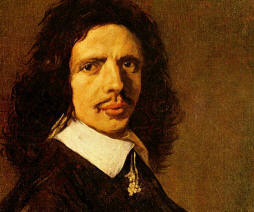100 Greatest Painters Artists Alphabetically Artists by Country Artists by Century Artists by Movement
Frans Hals
1582-1666
Dutch Baroque Realist Painter
Education: Studied under Flemish painter Karel van Mander

technique - oil or tempera on linen or oak panel
Frans Hals Biography
"Think of a people enslaved and oppressed for decades; compelled to witness the restoration of Catholic monasteries in its land and the proclamation of laws of medieval severity; a people which had, in a bloody struggle, thrown off the foreign yoke and achieved political and religious freedom. A bold and fiery generation grew up, conceived during the thunder of cannons in the battle and reaching manhood at the time of victory and fame. For such a generation the air they breath has something exhilarating. They fear neither hell nor the devil, but move about with clashing sabers and challenging glances. Their life is passed in reel and riot, in knightly war-play, at the banquet amid the chink of glass. Bayonets flash and the rattle of drums sounds. Should the Spaniards ever again come, these men, like their fathers, will be found at their posts.
Frans Hals was a true son of this sword clattering, mad, rollicking Holland. Evan in advanced years he felt like a Corpsstudent, joyous and light hearted, youthful and bold; an anti-philistine who would have considered the word bourgeois as an insult. One can imagine him in a state of exhilaration strolling through the streets at night, breaking windows and beating the night-watchmen ire in lieu of the night-watchmen, the village idiot.
His three earliest works in the museum of Haarlem are archers banquets, and it is no accident that Hals, the joyful genius of the Kneipe, invented this type of picture. A fresh love of pleasure and rugged health laughs from all faces. These are men who themselves had taken part in the defense of Haarlem, and now merrily enjoyed what they had accomplished; men who had smelt powder, had seen blood flow and passed the night on the battlefield. In a later work. the Archers of the Guild of St. Adrian are united under trees of their garden, armed cap-a-pie and prepared for the march. In the picture of 1639 representing the Departure of the Guild of St. George, Hals uses the motive of the staircase to bring new life into accustomed arrangement into rows. The colors are bold, fresh and joyous: red sashes and bright blue banners, the rich still-life of fruits and lobsters, and the silvery light streaming thru treetops.
In his smaller portraits also, joy in life, and self confident alacrity flash from every eye. If he paints children they do not weep or look serious, neither are they bashful or awkward. However small they are, they do not fear their elders, but look boldly and laughingly into their eyes. Even the nurse is full of a consciousness that her baby will become a field marshal or a Maid of Orleans. And these types of men! Here a little hunchback feels as brave as the giant Goliath, there a clergyman swings his bible in a warlike manner, as if he wished to bring it down upon the heads of Catholics; there again, a young man with his knees crossed cracks a whip as if in challenge. Franz Hals was not just a painter, but is the historian of Dutch liberty". -- Richard Muther, The History of Modern Painting, Henry and Co., London, 1896
Key Words, People and Principal Phrases, Characteristics Related to the Northern Renaissance Art Movement - allegorical painting, rebirth, invention of oil painting, Hieronymus Bosch, Limbourg Brothers, Desiderius Erasmus, Robert Campin, Jan Van Eyck, Jean Fouquet, Albrecht Dürer, Johannes Gutenberg, Johann Reuchlin, Martin Luther, rise of the merchant class, world landscape, Low Countries, Protestant Reformation, Calvinisim, glazing, impasto, scriptorium, illuminator, invention of the printing press, woodcuts, engravings, Antwerp School, Guild of Saint Luke, commerce, Flemish School, Northern Europe, Flanders, Bruges, renewed interest in classical learning, mythological scenes, genre painting, landscapes, portraits, moralizing overtones, human vices, lust, paradise, spirituality, piousness, living a simple life, reform, Human Reasoning, tradesmen at work, idyllic scenes of peasants, playing games, feasting, linear perspective, \Heliocentric Theory, humour, satire, spiritually significant, illuminated manuscript, idealized biblical themes, scriptorium, emotion, illuminator, iconoclast, Age of Discovery, Virgin and Child, axonometric drawing, curiosity about the natural world, realistic use of colours and light, Old Testament stories, Gospel parables, The Blackdeath, Christian symbolism
If you feel you have worthwhile information you would like to contribute we would love to hear from you. We collect essential biographical information and artist quotes from folks all over the globe and appreciate your participation. When submitting please, if possible, site the source and provide English translation. Email to historyofpainter@gmail.com
© HistoryofPainters.com 2017
If you like this page and wish to share it, you are welcome to link to it, with our thanks.
Popular Art History Questions
What is the difference between Italian Renaissance art and Northern Renaissance art?
How did the Black Death impact European art history?
How did the Inquisition impact European art history?
What was the influence of the Medici Academy on Renaissance painters?
What was the Bonfire of the Vanities?
Who were the greatest painters of the Renaissance?